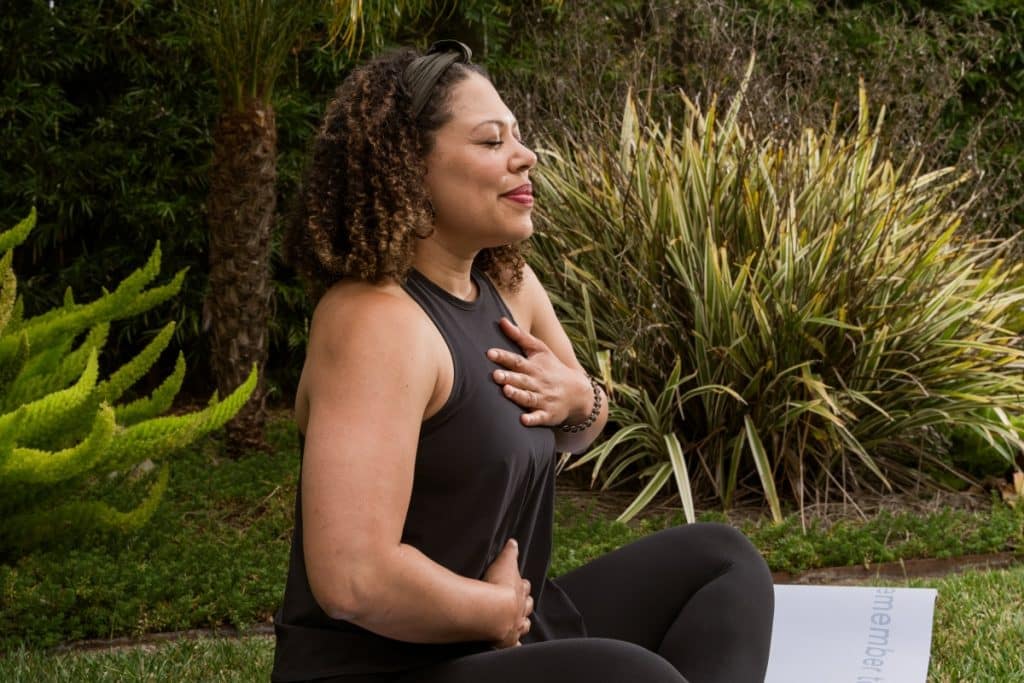
Blog
5 Ways to Cultivate Mindful Living Through Daily Intentions

Daily intentions and mindful living go hand-in-hand. Mindfulness doesn’t exclusively occur in a meditation class or on a Pilates mat (although these practices can be instrumental in helping you cultivate it). Mindfulness can permeate and enrich all facets of your life no matter where you are or what you’re doing.
But how do you make mindful living a natural, intuitive, habitual response in the midst of other obligations or distractions competing for your attention?
This is something I struggled with back in 2020 when it felt like the world was crashing down around all of us. The social and political unrest, coupled with challenges in my own personal life, made it feel like living mindfully was impossible—and painful.
I learned that creating daily intentions or even micro moments, can be a simple, beautiful way to start leaning into mindful living—even when life feels hard. At Lindywell, intentionality is at the core of what we do, providing strategies like gratitude affirmations and the healing power of the breath to forge a strong bond between mindfulness and intention. These practices are not just about cultivating a positive mindset but are essential tools for navigating life with grace and resilience.
So come with me as I share about what mindful living means and along with a few simple steps to start infusing meaningful daily intentions into your wellness routine.

The Power of Mindful Living
Mindfulness is a mental state characterized by a focused and nonjudgmental awareness of the present moment. It involves paying deliberate attention to thoughts, feelings, bodily sensations, and the surrounding environment without becoming overwhelmed or reactive.
According to Frontiers in Psychology, those who prioritize mindfulness in their daily lives are more likely to exhibit resilience, emotional regulation, acceptance of themselves and others, social sensitivity, personal well-being, life satisfaction, and a capacity to face obstacles without losing perspective. They’re also less prone to psychological distress (anxiety, depression, etc.). This practice plays a crucial role in mental health, allowing you to better manage stress and focus on personal growth.
Ultimately, the goal of mindfulness is to cultivate a deeper sense of connection to yourself and to others, more intentionality in your relationships, improved focus, more self-awareness, better concentration, and an overall better quality of life. A clear intention and goal setting are not just strategies but pathways to a more authentic self.
As such, “mindful living” is a holistic integration of mindfulness into your present life, which allows you to:
- Improve your relationships and social interactions.
- Nurture self-compassion.
- Cultivate a deeper sense of curiosity about the world.
- Pause, notice, and honor your own needs at any given moment.
Who doesn’t want to experience those incredible benefits? I know I do. And I do experience them as someone who lives mindfully more often than not—though not always because I’m not perfect, no one is!
The Link Between Mindfulness and Intention
Daily intentions reflect deliberate choices to cultivate the experience and outlook you want in life. The objective of intentional living is not to enforce rigid expectations on yourself or to manufacture a certain performance outcome. Rather, the goal is to honestly reflect on which thoughts, decisions, commitments, actions, and priorities align with your intrinsic values as a person.
Intentions help clarify what matters to you and how to chart your course in the right direction. They also empower you to ask courageous, introspective questions that reveal which aspects of yourself need extra care, focus, accountability, or even change. In other words, adopting daily intention setting is a powerful way to stay mindful as we navigate the challenges we’ll all inevitably face.
This can feel vulnerable and uncomfortable at first. The more you push through the discomfort, however, and live from this intentional space, the more mindful you become and the greater ease you’ll feel in all aspects of life.
Start your free trial of Lindywell to practice this mindfulness with a little guidance. Whether you’re doing one of our 300+ Pilates workouts or sitting through an on-demand guided breathwork with me, you’ll be building your mindfulness muscle!
5 Steps for Building Daily Intentions Into Your Routine
On average, it takes about 90 to 110 days of repetition for a new behavior to turn into a habit, so I want to start with this reminder: you have to commit to this practice of daily intentions if you want to see change long-term. When you do that, though, mindful living becomes natural. And let me tell you: it’s absolutely worth it!
Use these five steps to build intentions into your routine for a life of abundance, joyfulness, connection, and presence.
1. Ask Yourself Thoughtful Questions and Answer Honestly
Think about your goals, desires, values, and aspirations. What you care about helps determine which intentions to focus on. I want you to let go of toxic guilt and tap into your true desires. Carve out time for self-reflection and journal your answers to the following questions. From there, some potential daily intentions can begin to take shape.
- What lights me up inside? Can I focus my energy there?
- Where do I want to grow in my life?
- What is an unfulfilled desire I have been putting off?
- What mindset shifts do I want to cultivate, or what attributes do I want to embody?
- Where could I make an impact in the world?
- What limiting beliefs presently hold me back from being fully alive?
2. Be Sure Your Intentions Are Clear, Simple, and Attainable
The human brain is a multi-faceted organism, but it also needs a certain degree of simplicity. According to neuroscientist Amishi Jha, if whatever you’re focusing on feels too complex, your attention span will start to wander, making being present (being mindful) difficult.
To make your daily intentions effective and sustainable, don’t aim for the loftiest ambitions. Choose something clear and simple that you can feasibly incorporate into your routine. This will keep your attention fixed on a singular, attainable focal point, so you don’t get lost in the minutia of unrealistic expectations, which can lead to disappointment and frustration.
Powerful daily intentions, when set as a clear specific goal, not only foster motivation but also make success possible! You’re not just thinking about what you want to do—you have a plan to get there.
3. Frame Your Intentions Through a Lens of Empowerment
I like to say, don’t should all over yourself! Make sure your daily intentions empower you to embrace growth, authenticity, evolution, and well-being. If your intentions are rooted in shame or built around the assumption of how you “should” behave, this will only reinforce intrusive thoughts, harmful patterns, and limiting beliefs, which act as a barrier to mindful living.
Another study from Frontiers in Psychology found that negative emotions lead to ruminations on failure, counterproductive behaviors, and feelings of incompetence, all of which can stunt your growth potential. Intentions are meant to inspire and motivate, not burden you with pressure— that’s why we believe in the mantra of “grace over guilt” here at Lindywell.
4. Write Down Your Intentions and Keep Them Within Reach
New goal-setting research indicates that writing down what you hope to achieve in descriptive terms and even imagery will make you more likely to accomplish it. The reason for this is a neuroscientific process called encoding. When you write something, it tells your brain this information is worth storing as a long-term memory, similar to the way documenting positive statements for affirmations reinforces their importance.
Bottom line: writing down your intentions will help you articulate and remember the intentions you’ve set, which boosts the capacity to act on them. The more colorful your description, the easier it is to recall, so have fun with this!
Once you establish the right intention, you can also jot it down on a sticky note or note card and put it in a visible spot that you read as part of your morning routine or just notice throughout the day. This visual reminder will be a powerful tool to keep that intention front and center. Here are some examples of daily intentions:
- I will honor my needs in one small way every single day.
- I will spend time maintaining relationships with long-distance family members.
- I will create space for joy every single day.
5. Turn Your Intentions into Meaningful Action
The final component in this mindful living journey is to transform your intention from words into action. Below are some examples of daily intentions and the action steps needed to achieve them. You’ll see here that the action is very specific. When you know exactly what you need to do, you’re more likely to do it!
Intention: I will honor my needs in one small way every single day.
Action: Each day I will choose one thing to do solely for me, whether that’s a workout, a walk, or drinking a cup of coffee during my alone time.
Intention: I will spend time maintaining relationships with long-distance family members.
Action: I will prioritize honest communication and quality time with my loved ones each week. This could mean scheduling a phone call, or sending a text message to let them know that you’re thinking about them.
Intention: I will create space for joy every single day.
Action: I will add one spot in my weekly schedule for a playful activity or fun creative hobby and I will find an opportunity to laugh or smile at least once each day. You can read more about this in Robin’s chapter on ‘Play’ in her book, Well to the Core. It inspired me to be more intentional with this.
Take Your Intentions From Words to Action with Lindywell
Ready to embark on this pursuit of daily intentions and mindful living? Join our Lindywell community! As a member, you get instant access to nourishing recipes, dozens of conscious breathwork sessions (led by yours truly!), and 300+ Pilates exercises to help you invite balance, wellness, and presence into your life. Start your free trial today and embrace the power of mindful living.
share this post
Helping You Break Free!
Get your weekly delivery of inspiration—Pilates, nourishment,
& mindfulness—changing your relationship with food and your body.






3 thoughts on “5 Ways to Cultivate Mindful Living Through Daily Intentions”
I wish I was able to listen to all these wonderful blogs???As I prefer listening then reading on my phone or computer? I have been a member for four years now and enjoy everything about Lindywell. If there is a way to listen please let me know. Thank you.
Your computer may have text to speech programming that will read the blog to you
You may have the capability to convert text to speech on your device. Feel free to reach out to the Care Team at hello@lindywell.com for support. We’d be happy to help! We can also recommend the newly relaunch of the Well to the Core podcast! 🙂